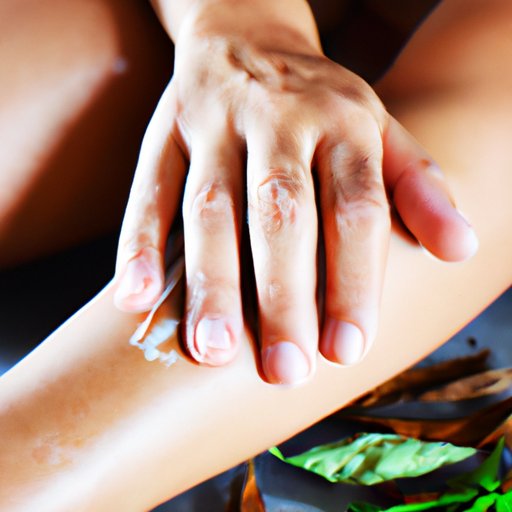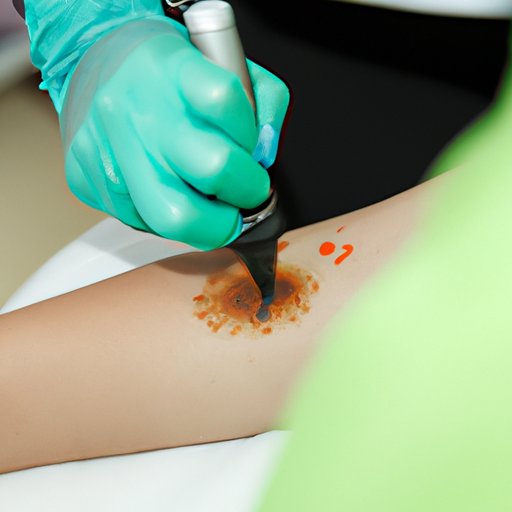
Introduction
Henna has been used traditionally in Eastern cultures for centuries for temporary tattoos, especially during festive times and weddings. Henna tattoos provide a beautiful, intricate design on the skin and can last up to two weeks. However, the problem arises when it’s time to remove the henna stains. Removing henna can be a frustrating process, with residual stains and skin irritation. In this article, we will discuss how to effectively remove henna stains using natural remedies and other methods.
The Natural Way: Using Olive Oil and Sugar Paste to Remove Henna
Olive oil and sugar paste is a natural and safe method to remove henna. Olive oil moisturizes the skin while the sugar exfoliates the skin, removing dead skin cells and henna stains.
To prepare the mixture, mix two tablespoons of olive oil with one tablespoon of sugar. Apply the paste onto the henna-stained skin and massage gently in circling motions. Leave the mixture on the skin for 10-15 minutes. Rinse the skin with warm water and pat dry.
One of the benefits of using natural remedies is that they are gentle on the skin and less likely to cause irritation. However, it is important to note that the paste may not remove all of the henna stain in one go. You may need to repeat the process several times.
It’s crucial to exfoliate the skin before applying the mixture to achieve better results. Be gentle whilst exfoliating to prevent skin irritation.
Get Sudsy: Using Dish Soap and Warm Water to Lift Stubborn Henna Stains
Dish soap is an effective cleaning agent and can help remove henna stains too. Mix dish soap with warm water, creating a soapy mixture, and apply it directly onto the henna stain. Use a soft cloth or sponge to rub the stained area gently. Rinse the skin with warm water and pat dry.
This method is advantageous because everyone has dish soap in their kitchen, making it an affordable remedy. However, this remedy may be too harsh for people with sensitive skin. Hence, caution is advised while using dish soap solution.
Acids to the Rescue: Removing Henna with Lemon Juice or White Vinegar
The acidity in lemon juice and white vinegar works as a natural bleaching agent. Apply lemon juice or white vinegar onto the henna-stained skin. Wait for a few minutes before washing it off with warm water. You can also mix lemon juice or white vinegar with water to dilute it; this method reduces the acidity in the remedy, making it less likely to irritate the skin.
One of the advantages of this method is that it’s using natural ingredients and therefore can be an excellent option for people who want to avoid using artificial detergents. Nonetheless, the acidity in lemons or vinegar may cause skin irritation, so it’s best to avoid using it regularly; try using this remedy once in a while to remove stubborn stains.
Exfoliate Away: Using a Pumice Stone or Salt Scrub to Remove Henna from Hands and Feet
Using a pumice stone or salt scrub can help exfoliate the skin, removing dead cells and henna stains in the process. Gently scrub the stained area with the stone or the salt scrub until the henna stain fades away. Rinse the skin with warm water and pat dry.
This method provides visible results instantaneously, making it a popular remedy. However, be aware that excessive exfoliation may cause skin irritation, and hence it should be done with caution.
Baking Soda Magic: Mix with Water to Create an Effective Henna Remover
Baking soda is an affordable household cleaning agent that can remove henna stains. Mix baking soda with water to create a paste. Apply the paste onto the henna-stained skin and leave it for a few minutes. Scrub the area gently with a soft cloth and rinse with warm water.
Using baking soda is beneficial because it’s readily available in most households; hence a convenient remedy. However, excessive use of baking soda may cause skin irritation, dryness or burning sensation. Hence, use with caution.
Hydrogen Peroxide Option: Mixing with Baking Soda to Elevate Henna and Reveal Skin
Hydrogen peroxide and baking soda form a powerful combination to remove henna stains from the skin. Mix a solution of hydrogen peroxide with baking soda in a bowl. Apply the mixture onto the henna stain. Leave the mixture on the stain for a few minutes and then wash it off with warm water.
Hydrogen peroxide works as a natural bleaching agent, which is why it is effective at lifting henna stains. Although this is a useful remedy, it is a little too harsh for people with sensitive skin. Furthermore, it should not be used excessively as it may cause skin dryness and irritation.

Seek Professional Help: Visit a Dermatologist for Laser Treatment to Remove Henna for Good
For those who want to remove henna for good, laser treatment is the best option. Laser treatment allows dermatologists to remove henna pigmentation permanently. However, it is a more expensive method compared to natural remedies, dish soap, and other methods.
One of the benefits of this method is that it’s swift and provides visible results that last longer compared to other remedies.
Conclusion
Removing henna stains can be a frustrating process, but thankfully, there are safe and effective methods that people can use at home. Natural remedies such as olive oil and sugar paste, salt scrubs, and baking soda are excellent choices. Some people prefer the chemical approach by using household detergents like dish soap or hydrogen peroxide. Alternatively, for those who want permanent results, laser treatment is a viable option.
Remember to use your chosen remedy with caution, keeping in mind the precautions and tips discussed in this article, and as a step towards healthier skin, moisturize your skin immediately after the treatment to prevent dryness or skin irritation.
Call to Action
If you have tried any other methods to remove henna or have any tips, drop a comment below to inform others who read this article. Share what works best for you, and get involved in the conversation.





